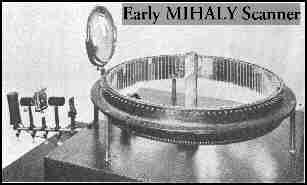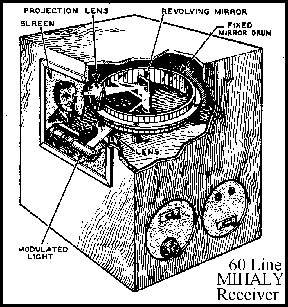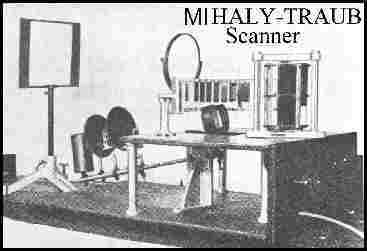|
Television Experimenters.com
Mihaly-Traub Scanner
Mihaly-Traub
Another innovative method of scanning was developed to overcome two of the major problems of mirror drums. The first was that with the higher line rates, so many mirrors were heavy. This made the drum difficult to keep in synchronization
with the picture signal. The second problem was that the tilt adjustments on each mirror required special tools and could only be made with the drum stationary. With the higher line rates, the adjustments became so critical that many attempts
needed to be made before a satisfactory adjustment could be achieved. This problem was compounded by the condition that with the drum operating at speed, centrifugal forces on the mirrors caused them to shift out of their preset positions.
The Mihaly-Traub scanner was basically a mirror drum turned inside out. It consists of a ring of stationary mirrors (one for each line), all facing inward. Each mirror has tilt adjustments, just as those on a mirror drum. In the center of the ring, there is a motor driven mirror, silvered on both sides. It rotates at half the picture rate. A beam of light, modulated with the picture signal is directed under the mirror ring to the lower part of the rotating mirror. From there, the light reflects to one of the mirrors in the ring, back to the upper part of the rotating mirror and then over the top of the ring and on to the screen. The rotation of the center mirror throws the beam of light on one stationary mirror after another. As the beam sweeps across each mirror in the ring, a corresponding scan line is focused on the screen. Because each mirror has a slightly different tilt from the one before and the one after, the scan lines are traced on the screen, just , below the previous one. Each rotation of the center mirror forms two complete pictures on the screen. The double reflection from the rotating mirror is an ingenious feature of this scanner allowing the scanner to be smaller than it might otherwise be. Another feature is that the stationary mirrors can be adjusted while the scanner is operating. |


|
With the original Mihaly-Traub scanner a stationary mirror was required for each line scanned. At some point, it was determined that the number of lines scanned was actually a product of the number of stationary mirrors times the number of rotating mirrors. Changing the rotating mirror to a six sided one, would allow the stationary mirrors to be reduced by a factor of three.
Furthermore, they would remain the same size as before, but only occupy one third of the circle (120 degrees), resulting in a further reduction in the size of the scanner. The central mirror, now rotating at picture speed had its six sides set at slightly different vertical angles. As one of these mirrors swept around, it scanned a group of lines, the same as the number of stationary mirrors. The next central mirror with a slightly different tilt, began its group of lines where the previous ones left off and
so on with the remaining mirrors. |

|
A typical scanner would have the stationary mirrors located on a 4" to 6" radius around the rotating mirror. In the center would be a rotating mirror assembly with four to ten sides. A scanner for 120 line transmissions might have a six sided rotating mirror working with 20 fixed mirrors in a 120 degree arc. Another design could use an eight sided rotating mirror with 15 fixed mirrors in a 90 degree arc, There are additional possibilities with center mirrors of 4, 5 or 10 sides, which you might work out as an exercise.
Because the image is projected on a screen, picture size is limited only by the amount of modulated light available. The advantages of the Mihaly-Traub scanner are similar to those of the mirror screw, but with the additional advantage of requiring a very small, easy to synchronize motor for the rotating mirror. A scanner of this sort was successfully operated on the British 405 line systems. |

All rights reserved.
|